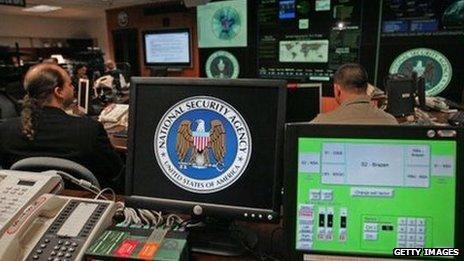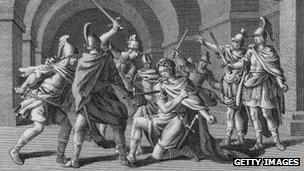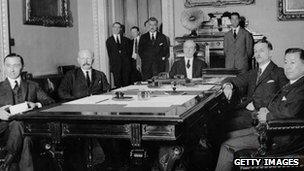Roman Empire to the NSA: A world history of government spying
- Published

The NSA surveillance program is the latest chapter in a long history of government surveillance
Revelations about the US National Security Agency's spying have provoked global outrage. But government snooping is nothing new.
Chinese general Sun Tzu wrote in his famous treatise The Art of War: "Enlightened rulers and good generals who are able to obtain intelligent agents as spies are certain for great achievements."
Purloined letters, intercepted communications, official eavesdropping - here are some examples of spying over the ages, by enlightened rulers and not-so-enlightened ones.
Caesar's spies
In Ancient Rome, major political players had their own surveillance networks, which provided them with information about the schemes of those in power.

An extensive spy network couldn't save Julius Caesar
Politician and orator Cicero frequently lamented that his letters were being intercepted.
"I cannot find a faithful message-bearer," he wrote to his friend, the scholar Atticus. "How few are they who are able to carry a rather weighty letter without lightening it by reading."
Julius Caesar put together an elaborate spy network to keep himself apprised of the various plots against him. In fact, Caesar may have known about the Senate-led conspiracy that culminated in his assassination.
Even the best spy network sometimes cannot stop a dagger.
In the Middle Ages, the Roman Catholic Church was more powerful than most governments - and it had a powerful surveillance network to match.
French Bishop Bernard Gui was a noted author and one of the leading architects of the Inquisition in the late 13th and early 14th Centuries. For 15 years, he served as head inquisitor of Toulouse, where he convicted more than 900 individuals of heresy.
A noted author and historian, Gui was best known for the Conduct of the Inquisition into Heretical Depravity, written in 1323-24, in which he outlined the means for identifying, interrogating and punishing heretics.
The court of Elizabeth I was fertile ground for scheming and spies, and Francis Walsingham's job was to keep the monarch one step ahead of her adversaries.
In May 1582, Walsingham intercepted letters written by Spanish ambassador to England, Bernardino de Mendoza, regarding a conspiracy to invade England and install Mary, Queen of Scots to the throne.
While Mary was confined to Chartley Manor, Walsingham came up with a way to prove she was a threat to the queen. He had most of her mail opened, but led her to believe that she had a secret means of correspondence through letters hidden in a beer keg.
Walsingham gathered evidence of Mary's involvement in rebellious plots. She was put on trial for treason and beheaded.
Robespierre's watchmen
Mary learned the hard way that what you think the government is reading is not as essential as what you think the government isn't reading.

US cryptographers intercepted diplomatic communications at a 1922 conference
During the French Revolution, Maximilien Robespierre and his cohort watched the population with a careful eye and ruthlessly cracked down on internal dissent.
In 1793, the revolutionary government established 12-member "committees of surveillance" throughout the country. They were authorised to identify, monitor and arrest any suspicious former nobles, foreigners, nationals who had recently returned from abroad, suspended public officials and many more.
Historians estimate that as many as half a million people were targeted by the surveillance committees, which were particularly ruthless in smaller French towns.
When neighbours have the power to spy, the results can be tragic.
In the 18th and 19th Centuries, governments undertook surveillance with bureaucratic gusto. Across Europe, they established departments called "black chambers" (from the French, cabinet noir) to read the letters of targeted individuals.
The bureaux, usually located in post office buildings, employed a variety of techniques to surreptitiously open, copy and reseal correspondence, then forward the missives on to the unsuspecting recipients.
The practice embroiled the British government in scandal in 1844 when it was revealed that the London black chamber was secretly reading the mail of exiled Italian author and activist Giusseppe Mazzini.
Many in the British public were outraged that their government had passed information to the Neapolitans, who used it to execute Mazzini's fellow revolutionaries.
In Europe, the industrial revolution was also a revolution in spycraft.
Negotiating with espionage
In 1922, the United States hosted a naval disarmament conference in Washington, where it oversaw talks among nine nations, including United Kingdom, France, Italy and Japan.

The intelligence agency Stasi kept files on 10 million East Germans
It also spied on the Japanese and other negotiating teams, intercepting and decrypting communications between delegations and their home countries.
Thanks in part to inside knowledge about negotiation positions provided by the US Cipher Bureau, the government cryptography office founded A world history of government spyingin 1919, the US was able to successfully broker several multinational treaties and agreements that headed off a naval arms race.
In 1929, the Cypher Bureau was shut down by Secretary of State Henry Stimson, who said: "Gentlemen don't read each other's mail."
After World War Two, the Americans decided gentlemen need a permanent surveillance network.
Behind the Cold War's Iron Curtain, surveillance of the population was an everyday part of life. Nowhere was this more prevalent than in East Germany, where for nearly 40 years the Stasi intelligence service monitored and reported on the activities of its citizens, using the information to stifle unrest.
By the time the Berlin Wall fell in 1989, the Stasi had grown to more than 91,000 officers, with an active informer network of close to 200,000.
The East German surveillance state used modern technology and massive manpower to expand government spying on a previously unimaginable scale.
The United States entered the surveillance business in earnest following World War Two, when it began collecting and monitoring all telegraph information coming into and out of the country as part of Project Shamrock. It also created a "watch list" of US citizens suspected of "subversive" activities whose communications it kept tabs on as part of Project Minaret.
The operation was taken over by the newly formed National Security Agency (NSA), which co-operated with the FBI and CIA. Both programmes were shut down after an investigation by the US Congress in 1975.
Thirty-eight years later, the NSA has rebuilt Project Shamrock using the technology of the information age.
And the rest, as they say, is history...